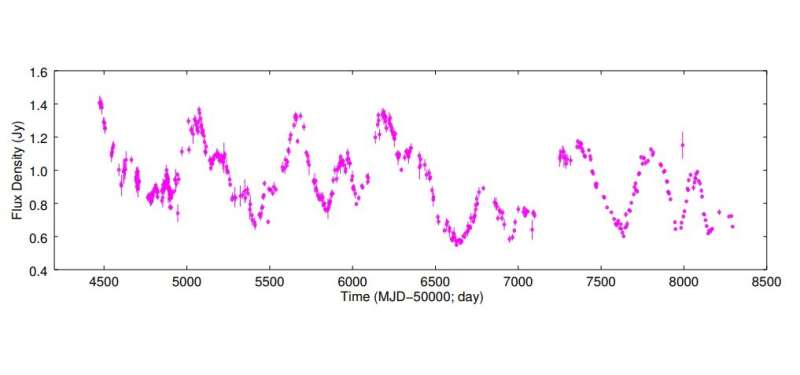December 12, 2018 report
Periodic radio signal detected from the blazar J1043+2408

Using Owens Valley Radio Observatory (OVRO), astronomers have detected a periodic signal in the radio light curve of the blazar J1043+2408, which could be helpful in improving our understanding about the nature of blazars in general. The finding was presented in a paper published November 30 on arXiv.org.
Blazars are a class of radio-loud active galactic nuclei (AGN). Their characteristic features are relativistic jets pointed almost exactly toward the Earth. In general, blazars, which are the most energetic sources in the universe, are perceived by astronomers as high-energy engines serving as natural laboratories to study particle acceleration, relativistic plasma processes, magnetic field dynamics and black hole physics.
BL Lacertae objects (BL Lacs) are a type of blazar showcasing lower-power jets and higher Doppler factors than other blazars. J1043+2408 is one of the objects of this type, frequently observed by space telescopes and ground-based observatories.
By monitoring such BL Lacs like J1043+2408 astronomers hope to find quasi-periodic oscillations (QPOs) in the multi-frequency light curves, including radio, optical, X-ray and gamma-ray. For instance, at radio frequencies, QPOs with periods ranging from few hours to few years have been recorded in a number of blazars. These periodic signals could provide essential insights into aspects of blazar studies, including disk-jet connection, magnetic field configuration and strong gravity near supermassive black holes.
Now, in a new study, a group of astronomers led by Gopal Bhatta of Jagiellonian University in Kraków, Poland, reports finding a periodic radio signal in J1043+2408. The detection is the result of long-term observations of this blazar over more than 10 years, using OVRO's 40-m telescope.
"In this work, we report detection of a periodic signal in the radio light curve of the blazar J1043+2408 spanning ~10.5 years. We performed multiple methods of time series analysis, namely, epoch folding, Lomb-Scargle periodogram, and discrete auto-correlation function," the researchers wrote in the paper.
The observations revealed a repeating radio signal with a periodicity of about 563 days. The researchers noted that a signal with such periodic modulation could be explained by various scenarios, including binary supermassive black hole system, the so-called Lense-Thirring precession and jet precession.
However, the authors of the study concluded that in the case of J1043+2408, gravitational perturbation in a binary supermassive black hole is the most plausible hypothesis.
"We conclude that while other above-discussed scenarios can not be completely ruled out, periodic modulations induced by gravitational perturbation in binary SMBH [supermassive black hole] system seems a more plausible mechanism at the root of the observed periodic radio signal," the paper reads.
The astronomers added that studies of periodic oscillations in objects like J1043+2408 could be essential for advancing our knowledge about the processes in the innermost regions of blazars. Given that there are currently numerous scenarios explaining such modulations, further observations are required to help better determine the driving mechanisms of this activity.
More information: Gopal Bhatta. Detection of periodic radio signal from the blazar J1043+2408. arXiv:1811.12689 [astro-ph.HE]. arxiv.org/abs/1811.12689
© 2018 Science X Network





















